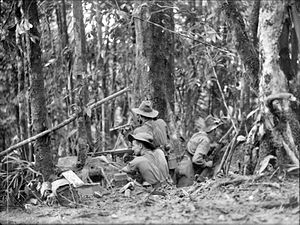Battle of Mount Tambu
| Battle of Mount Tambu | |||||||
|---|---|---|---|---|---|---|---|
| Part of World War II, Pacific War | |||||||
 2/5th Infantry Battalion soldiers around Mount Tambu, July 1943 |
|||||||
|
|||||||
| Belligerents | |||||||
|
|
|
||||||
| Commanders and leaders | |||||||
| Murray Moten | Fukuzo Kimura Sakai Sugiyama |
||||||
| Units involved | |||||||
| Strength | |||||||
| One brigade + | Two understrength battalions | ||||||
The Battle of Mount Tambu was a series of actions fought in the Salamaua area of the Territory of New Guinea between Allied and Japanese forces, which took place between 16 July and 18 August 1943, during World War II. The battle formed part of the wider Salamaua–Lae campaign and was fought in the final stages of the campaign, which had seen a combined Australian and US force advance from Wau towards Salamaua following the repulse of the Japanese attack on Wau in late January and early February 1943. After several frontal assaults on the position by Australian and US infantrymen were rebuffed by determined Japanese defenders, an indirect approach was sought and flanking moves were undertaken to cut off the Japanese supply route along the Komiatum Track. This succeeded in eventually forcing the Japanese off the position as they withdrew to avoid encirclement.
In late January and early February 1943, Japanese efforts to secure a vital airfield at Wau were checked by a small Australian force, leading to the end of Japanese attempts to capture Port Moresby. This victory was followed up by the Australians as they pushed into the surrounding area. Following actions around Mubo and Lababia Ridge in late June and early July 1943, the Australian troops from Brigadier Murray Moten's 17th Brigade was ordered to push towards the Komiatum and Mount Tambu area—about 6 miles (9.7 km) from Salamaua—as the Allies advanced towards Salamaua, with a view to tying down Japanese reserves there, to divert their attention away from Lae.
The highest feature on the route between Mubo and Salamaua, Mount Tambu consisted of a series of steep razorback ridges that were covered in dense jungle. Throughout July and August, troops from the Second Australian Imperial Force 2/5th and 2/6th Infantry Battalions and the Militia 42nd Infantry Battalion, undertook a series of actions around Mount Tambu and Komiatum. The area was defended by around 700 Japanese troops, from two battalions of the 66th Infantry Regiment under the command of Lieutenant Colonel Fukuzo Kimura and Major Sakai Sugiyama; initially the position was defended by only Sugiyama's II Battalion but in mid-July, Kimura's III Battalion arrived to reinforce them. These actions were fought in conjunction with actions in the surrounding area, which also included attacks on Bobdubi, an amphibious landing by US troops at Nassau Bay and actions around Roosevelt Ridge.
...
Wikipedia
